A Theoretical and Experimental Investigation on the Fracture Mechanism of Center-Symmetric Closed Crack in Compacted Clay under Compression–Shear Loading
Abstract
1. Introduction
2. Stress Field of Closed Cracks under Compression-Shear Loading
2.1. Classical Fracture Mechanics Theory
2.2. Modified Fracture Mechanics Theory by Considering T-Stress
3. Theoretical Fracture Mechanism
3.1. Fracture Criterion of Compression-Shear Closed Cracks Considering T-Stress
3.2. Effect of Compression-Shear Closed Crack Initiation Behaviors
3.2.1. Effect of Lateral Pressure Coefficient
3.2.2. Effect of Crack Inclination Angle
3.2.3. Effect of Crack Friction Coefficient
3.2.4. Effect of Critical Size of Crack Tip
4. Experimental Procedures
4.1. Test Materials
4.2. Specimen Preparation Molds
4.3. Specimen Preparation Method
- (1)
- The masses of natural clay and water required were calculated based on the predetermined dry density (1.66 g/cm3) and water content (16.6%), see Figure 10a.
- (2)
- The weighted soil and water were mixed evenly in a container (Figure 10b) and sealed for 24 h.
- (3)
- The mixed soil was evenly spread into the cubic mold in three layers for compaction, ensuring that the compaction effort was the same for each layer. Scraping should be performed for each layer to ensure good integrity of the specimen, and petroleum jelly should be applied evenly on the inner wall of the mold and on the surface of the gaskets before compaction, see Figure 10c.
- (4)
- The clay specimen was moved out by dismantling the mold, and the next step was filling the opening cracks of the specimen. Paraffin wax was heated at a high temperature to make it melt into a liquid state. After being filled with liquid paraffin wax, the specimen was left undisturbed until the wax solidified, completing the preparation of the specimen with central closed cracks, see Figure 10d.

4.4. Loading Method and Test Protocol
5. Experiment Results
5.1. Stress-Strain Curve
5.2. Crack Propagation Process
6. Discussion
6.1. Comparison of Test Results and Theoretical Values at Different Crack Inclination Angles
6.2. Comparison of Experimental Results with Theoretical Values at Different Crack Lengths
7. Conclusions
Author Contributions
Funding
Data Availability Statement
Conflicts of Interest
References
- Xu, J.; Tang, C.; Cheng, Q.; Xu, Q.; Inyang, H.I.; Lin, Z.; Shi, B. Investigation on desiccation cracking behavior of clayey soils with a perspective of fracture mechanics: A review. J. Soil Sediment 2022, 22, 859–888. [Google Scholar] [CrossRef]
- Camp, S.; Gourc, J.P.; Ple, O. Landfill clay barrier subjected to cracking: Multi-scale analysis of bending tests. Appl. Clay Sci. 2010, 48, 384–392. [Google Scholar] [CrossRef]
- Zhang, H.; Jing, Y.; Chen, J.; Gao, Z.; Xu, Y. Characteristics and causes of crest cracking on a high core-wall rockfill dam: A case study. Eng. Geol. 2022, 297, 106488. [Google Scholar] [CrossRef]
- Ji, E.; Fu, Z.; Chen, S.; Zhu, J.; Geng, Z. Numerical Simulation of Hydraulic Fracturing in Earth and Rockfill Dam Using Extended Finite Element Method. Adv. Civ. Eng. 2018, 2018, 1782686. [Google Scholar] [CrossRef]
- Thusyanthan, N.I.; Take, W.A.; Madabhushi, S.P.G.; Bolton, M.D. Crack initiation in clay observed in beam bending. Géotechnique 2007, 57, 581–594. [Google Scholar] [CrossRef]
- Liu, H.; Lin, J.; He, J.; Xie, H. Dominant mode of planar fractures and the role of material properties. Eng. Fract. Mech. 2018, 195, 57–79. [Google Scholar] [CrossRef]
- Skempton, A.W.; Schuster, R.L.; Petley, D.J. Joints and Fissures in The London Clay at Wraysbury and Edgware. Géotechnique 1970, 20, 208–209. [Google Scholar] [CrossRef]
- Qiao, L.; Liu, J.; Li, X.; Li, Q.; Xie, J. Experimental study on mode I fracture characteristics of compacted bentonite clay. Eng. Fract. Mech. 2023, 285, 109294. [Google Scholar] [CrossRef]
- Wang, J.; Huang, S.; Guo, W.; Qiu, Z.; Kang, K. Experimental study on fracture toughness of a compacted clay using semi-circular bend specimen. Eng. Fract. Mech. 2020, 224, 106814. [Google Scholar] [CrossRef]
- Wang, J.; Huang, S.; Hu, J. Limit of crack depth in KIC testing for a clay. Eng. Fract. Mech. 2016, 164, 19–23. [Google Scholar] [CrossRef]
- Wang, J.; Zhu, J.; Chiu, C.F.; Zhang, H. Experimental study on fracture toughness and tensile strength of a clay. Eng. Geol. 2007, 94, 65–75. [Google Scholar] [CrossRef]
- Amarasiri, A.L.; Costa, S.; Kodikara, J.K. Determination of cohesive properties for mode I fracture from compacted clay beams. Can. Geotech. J. 2011, 48, 1163–1173. [Google Scholar] [CrossRef]
- Williams, J.G.; Ewing, P.D. Fracture under complex stress—The angled crack problem. Int. J. Fract. Mech. 1972, 8, 441–446. [Google Scholar] [CrossRef]
- Fan, Y.; Zhu, Z.; Zhao, Y.; Zhou, L.; Qiu, H.; Niu, C. Analytical solution of T-stresses for an inclined crack in compression. Int. J. Rock Mech. Min. 2021, 138, 104433. [Google Scholar] [CrossRef]
- Sakha, M.; Nejati, M.; Aminzadeh, A.; Ghouli, S.; Saar, M.O.; Driesner, T. On the validation of mixed-mode I/II crack growth theories for anisotropic rocks. Int. J. Solids Struct. 2022, 241, 111484. [Google Scholar] [CrossRef]
- Ayatollahi, M.R.; Aliha, M.R.M. On the use of Brazilian disc specimen for calculating mixed mode I–II fracture toughness of rock materials. Eng. Fract. Mech. 2008, 75, 4631–4641. [Google Scholar] [CrossRef]
- Zhao, Y.; Wang, Y.; Tang, L. The compressive-shear fracture strength of rock containing water based on Druker-Prager failure criterion. Arab. J. Geosci. 2019, 12, 452. [Google Scholar] [CrossRef]
- Sun, D.; Rao, Q.; Wang, S.; Shen, Q.; Yi, W. Shear fracture (Mode II) toughness measurement of anisotropic rock. Theor. Appl. Fract. Mec. 2021, 115, 103043. [Google Scholar] [CrossRef]
- Miao, S.; Pan, P.; Yu, P.; Zhao, S.; Shao, C. Fracture analysis of Beishan granite after high-temperature treatment using digital image correlation. Eng. Fract. Mech. 2020, 225, 106847. [Google Scholar] [CrossRef]
- Liu, H. Wing-crack initiation angle: A new maximum tangential stress criterion by considering T-stress. Eng. Fract. Mech. 2018, 199, 380–391. [Google Scholar] [CrossRef]
- Erdogan, F.; Sih, G.C. On the Crack Extension in Plates Under Plane Loading and Transverse Shear. J. Basic Eng. 1963, 85, 519–525. [Google Scholar] [CrossRef]
- Irwin, G. Analysis of Stresses and Strains Near End of a Crack Traversing a Plate. J. Appl. Mech. 1957, 24, 361–364. [Google Scholar] [CrossRef]
- Zhang, X.; Wong, L.N.Y. Cracking Processes in Rock-Like Material Containing a Single Flaw Under Uniaxial Compression: A Numerical Study Based on Parallel Bonded-Particle Model Approach. Rock Mech. Rock Eng. 2011, 45, 711–737. [Google Scholar] [CrossRef]
- Lin, H.; Yang, H.; Wang, Y.; Zhao, Y.; Cao, R. Determination of the stress field and crack initiation angle of an open flaw tip under uniaxial compression. Theor. Appl. Fract. Mec. 2019, 104, 102358. [Google Scholar] [CrossRef]
- Smith, D.J.; Ayatollahi, M.R.; Pavier, M.J. The role of T-stress in brittle fracture for linear elastic materials under mixed-mode loading. Fatigue Fract. Eng. M 2001, 24, 137–150. [Google Scholar] [CrossRef]
- Aminzadeh, A.; Bahrami, B.; Ayatollahi, M.R.; Nejati, M. On the role of fracture process zone size in specifying fracturing mechanism under dominant modeII loading. Theor. Appl. Fract. Mec. 2022, 117, 103150. [Google Scholar] [CrossRef]
- Wei, M.; Dai, F.; Liu, Y.; Li, A.; Yan, Z. Influences of Loading Method and Notch Type on Rock Fracture Toughness Measurements: From the Perspectives of T-Stress and Fracture Process Zone. Rock Mech. Rock Eng. 2021, 54, 4965–4986. [Google Scholar] [CrossRef]
- Cotterell, B. Brittle fracture in compression. Int. J. Fract. Mech. 1972, 8, 195–208. [Google Scholar] [CrossRef]
- Ayatollahi, M.R.; Rashidi Moghaddam, M.; Berto, F. T-stress effects on fatigue crack growth—Theory and experiment. Eng. Fract. Mech. 2018, 187, 103–114. [Google Scholar] [CrossRef]
- Tang, S.; Dong, Z.; Huang, R. Determination of T-stress using finite element analysis. Sci. China Technol. Sci. 2017, 60, 1211–1220. [Google Scholar] [CrossRef]
- Ayatollahi, M.R.; Pavier, M.J.; Smith, D.J. Mode I cracks subjected to large T-stresses. Int. J. Fract. 2002, 117, 159–174. [Google Scholar] [CrossRef]
- Roychowdhury, S.; Dodds, R.H. Effect of T-stress on fatigue crack closure in 3-D small-scale yielding. Int. J. Solids Struct. 2004, 41, 2581–2606. [Google Scholar] [CrossRef]
- Aliha, M.R.M.; Ayatollahi, M.R.; Smith, D.J.; Pavier, M.J. Geometry and size effects on fracture trajectory in a limestone rock under mixed mode loading. Eng. Fract. Mech. 2010, 77, 2200–2212. [Google Scholar] [CrossRef]
- Nasiraldin Mirlohi, S.; Aliha, M.R.M. Crack growth path prediction for the angled cracked plate using higher order terms of Williams series expansion. Eng. Solid Mech. 2013, 1, 77–84. [Google Scholar] [CrossRef]
- Mousavi, S.S.; Aliha, M.R.M.; Imani, D.M. On the use of edge cracked short bend beam specimen for PMMA fracture toughness testing under mixed-mode I/II. Polym. Test 2020, 81, 106199. [Google Scholar] [CrossRef]
- Torabi, A.R.; Jabbari, M.; Akbardoost, J. Mixed mode notch fracture toughness assessment of quasi-brittle polymeric specimens at different scales. Theor. Appl. Fract. Mec. 2020, 109, 102682. [Google Scholar] [CrossRef]
- Aliha, M.R.M.; Mousavi, S.S. Sub-sized short bend beam configuration for the study of mixed-mode fracture. Eng. Fract. Mech. 2020, 225, 106830. [Google Scholar] [CrossRef]
- Bahmani, A.; Aliha, M.R.M.; Jebalbarezi Sarbijan, M.; Mousavi, S.S. An extended edge-notched disc bend (ENDB) specimen for mixed-mode I+II fracture assessments. Int. J. Solids Struct. 2020, 193–194, 239–250. [Google Scholar] [CrossRef]
- Tang, S.B.; Bao, C.Y.; Liu, H.Y. Brittle fracture of rock under combined tensile and compressive loading conditions. Can. Geotech. J. 2017, 54, 88–101. [Google Scholar] [CrossRef]
- Sih, G.C. Strain-energy-density factor applied to mixed mode crack problems. Int. J. Fract. 1974, 10, 305–321. [Google Scholar] [CrossRef]
- Nuismer, R.J. An energy release rate criterion for mixed mode fracture. Int. J. Fract. 1975, 11, 245–250. [Google Scholar] [CrossRef]
- Chen, H.; Xing, H.; Imtiaz, H.; Liu, B. How to obtain a more accurate maximum energy release rate for mixed mode fracture. Forces Mech. 2022, 7, 100077. [Google Scholar] [CrossRef]
- Tang, S.B. The effect of T-stress on the fracture of brittle rock under compression. Int J Rock Mech Min 2015, 79, 86–98. [Google Scholar] [CrossRef]
- Schmidt, R. A microcrack model and its significance to hydraulic fracturing and fracture toughness testing. In Proceedings of the 21st U.S. Symposium on Rock Mechanics (USRMS), Rolla, MI, USA, 27–30 May 1980; pp. 581–590. [Google Scholar]
- Ayatollahi, M.R.; Razavi, S.M.J.; Berto, F. Crack path stability in brittle fracture under pure mode I loading. Procedia Struct. Integr. 2018, 13, 735–740. [Google Scholar] [CrossRef]
- Wang, J.; Lv, C.; Huang, S.; Qiu, Z. Size effect on fracture behavior of quasi-brittle materials during uniaxial compression tests. Arch. Appl. Mech. 2023, 93, 3171–3188. [Google Scholar] [CrossRef]
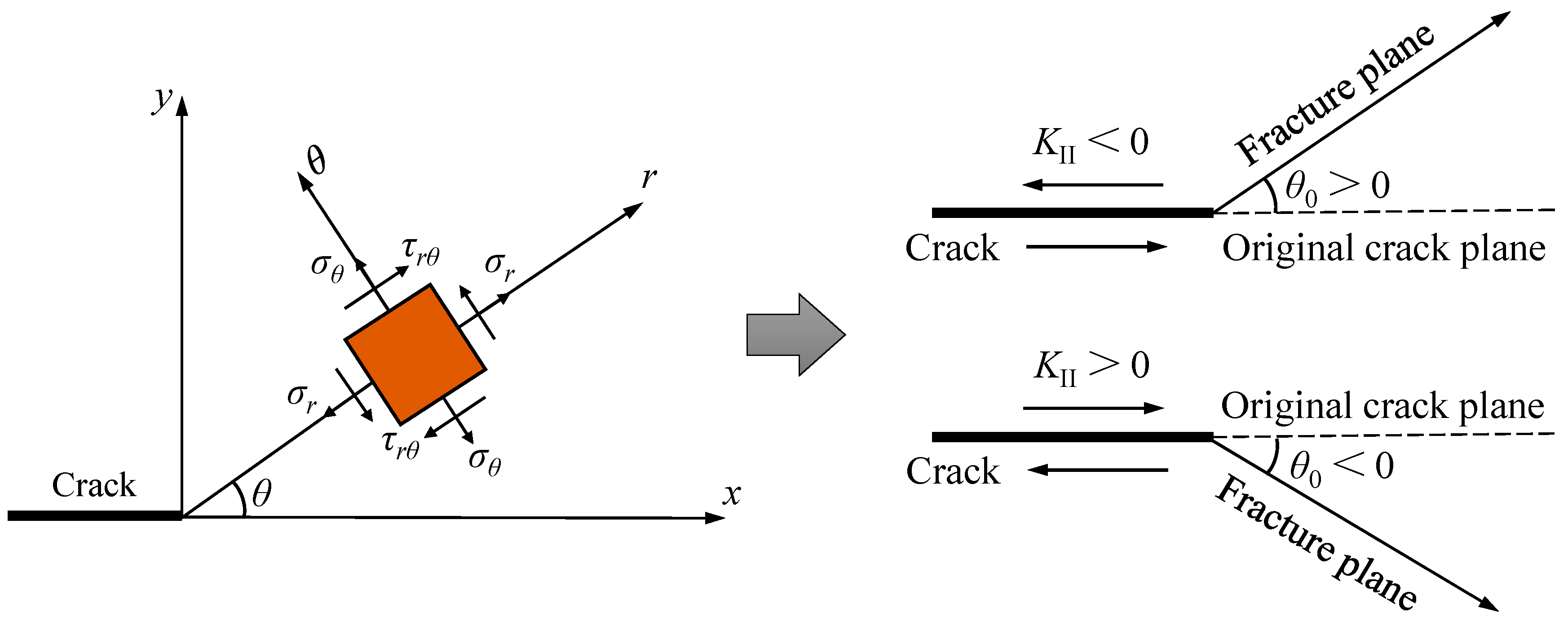
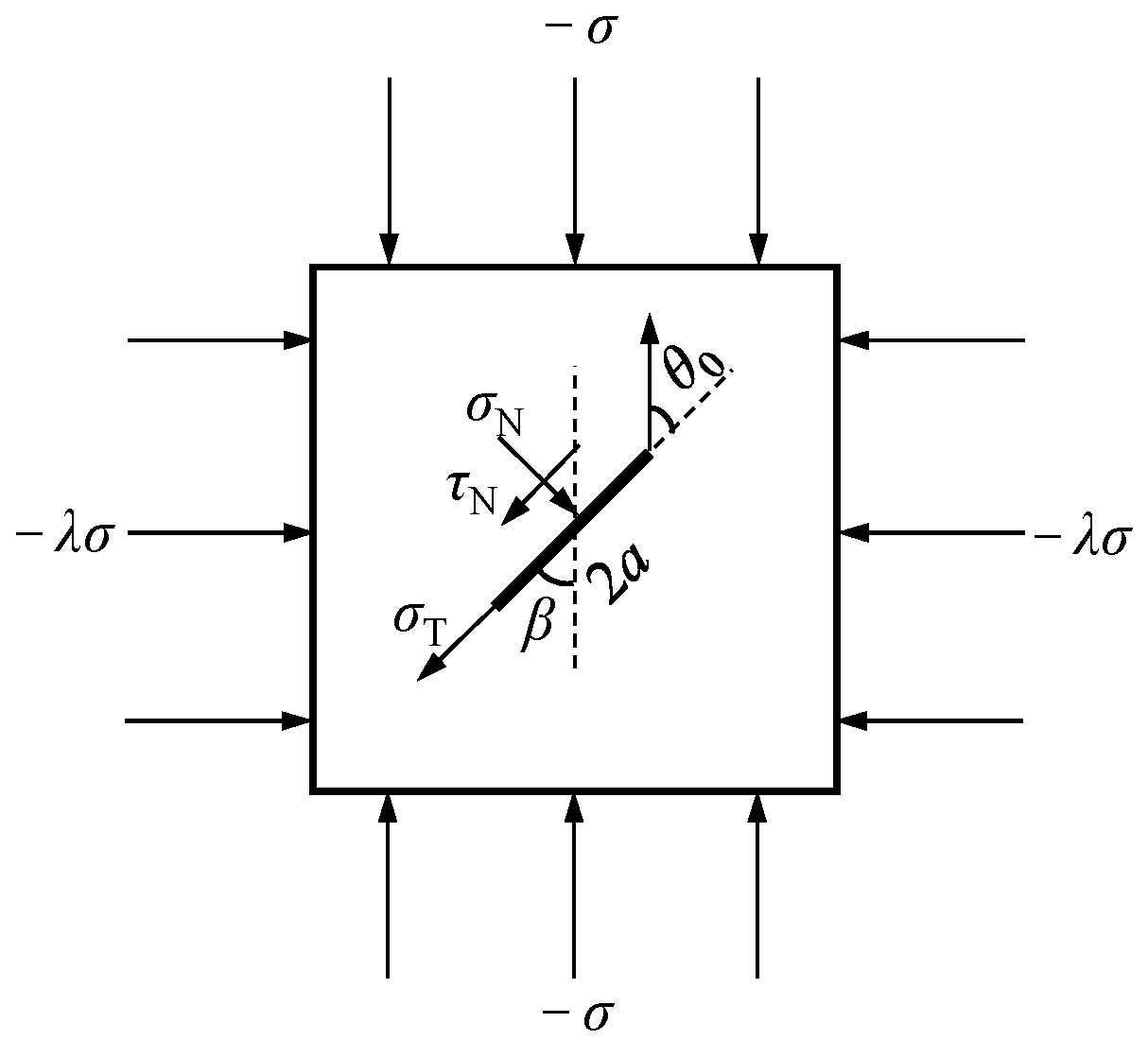
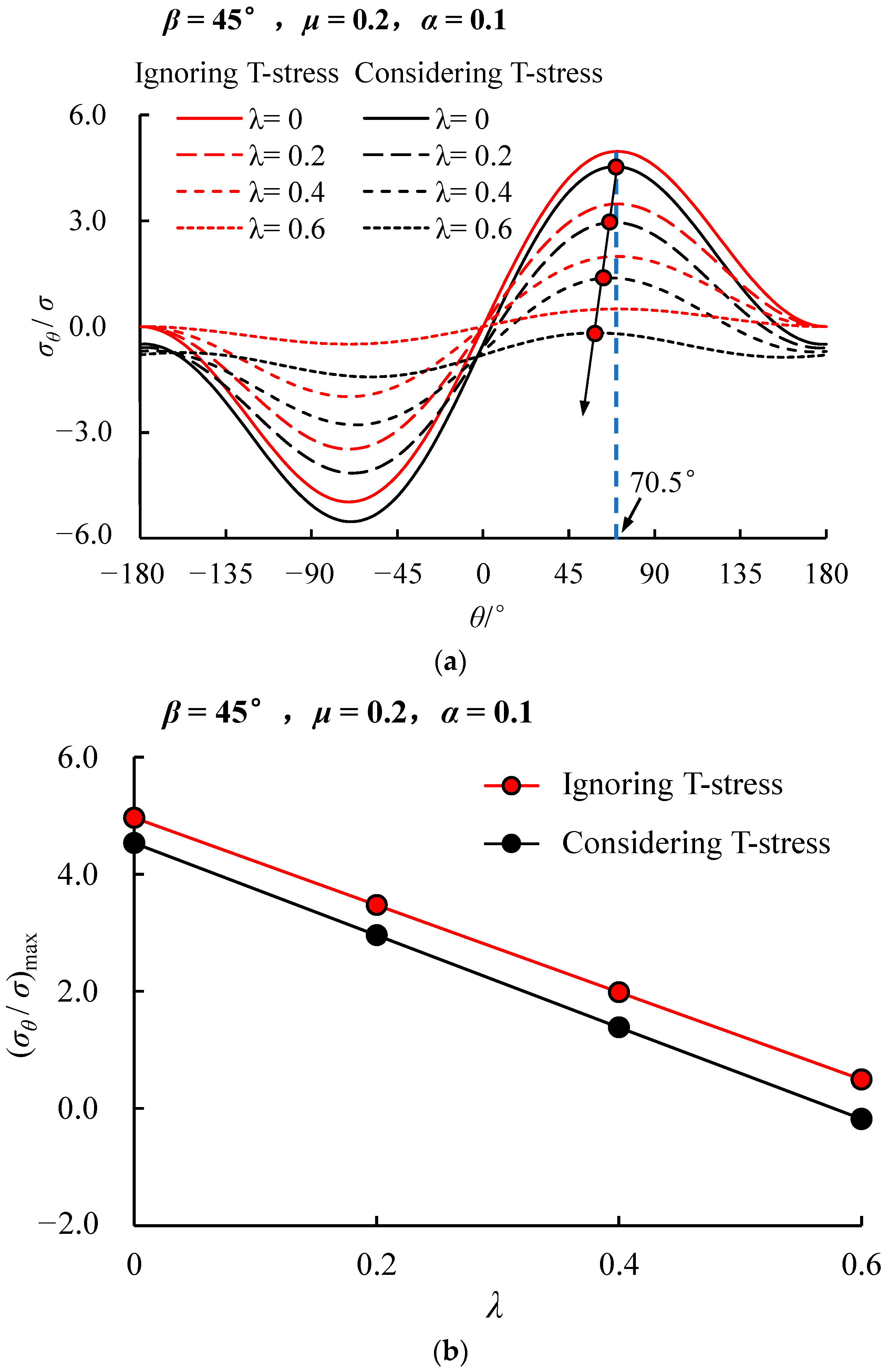


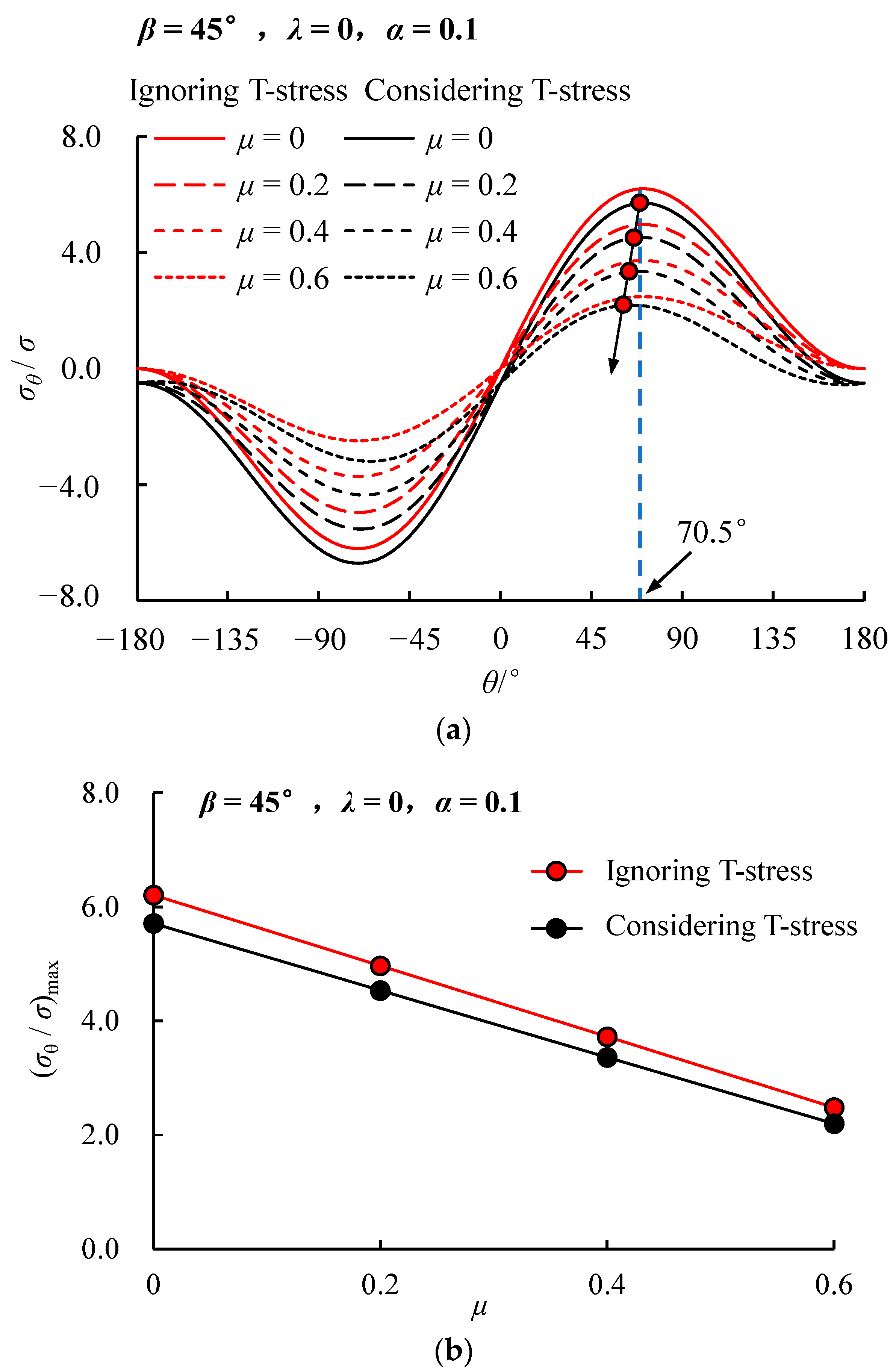

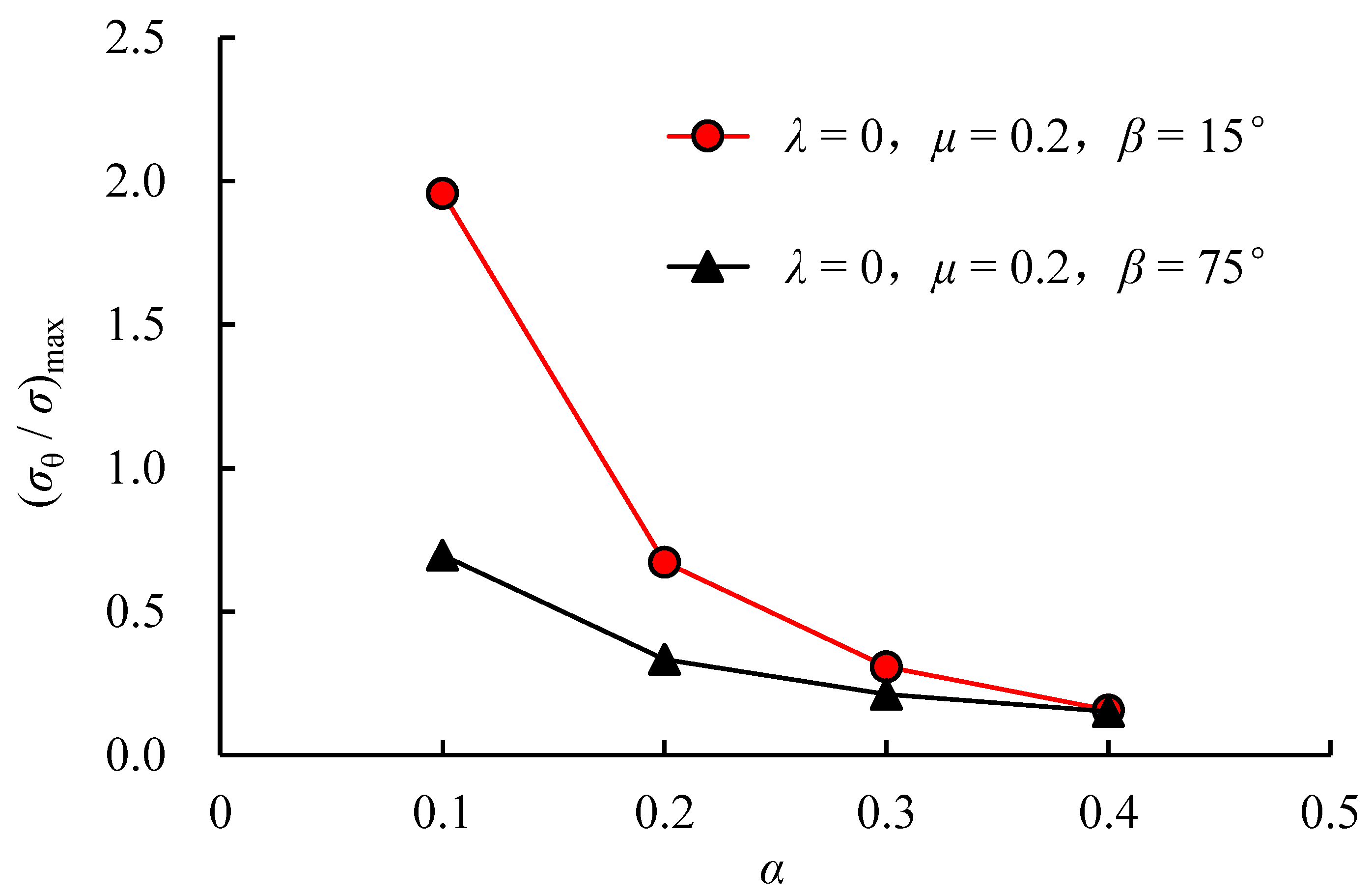
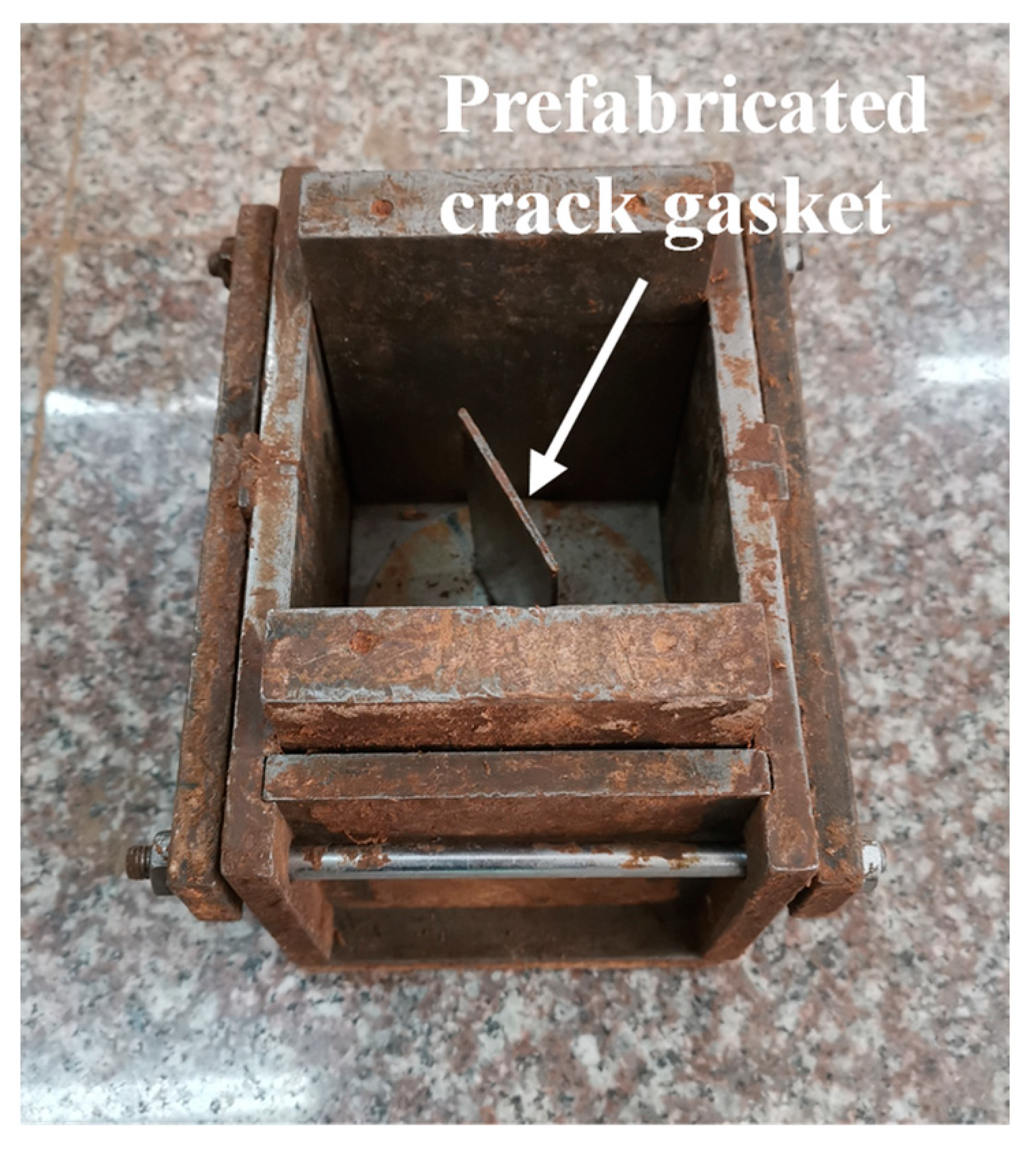
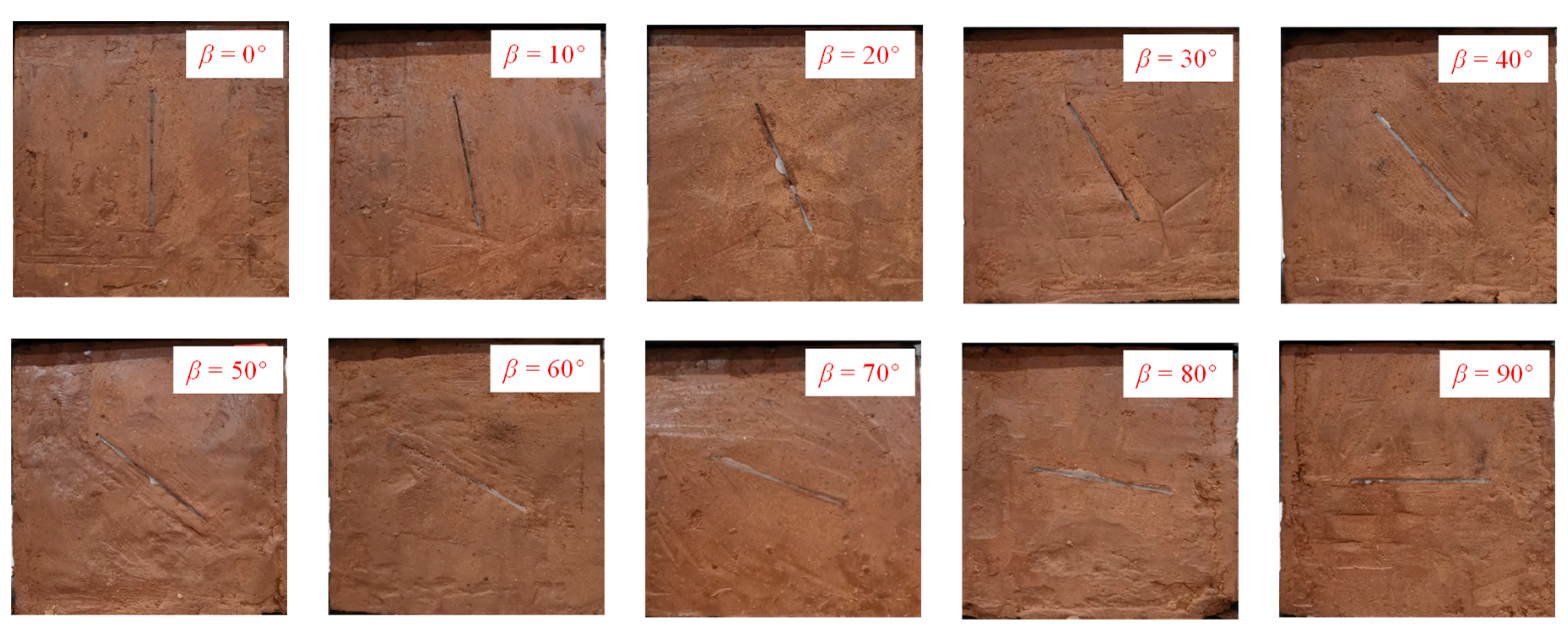

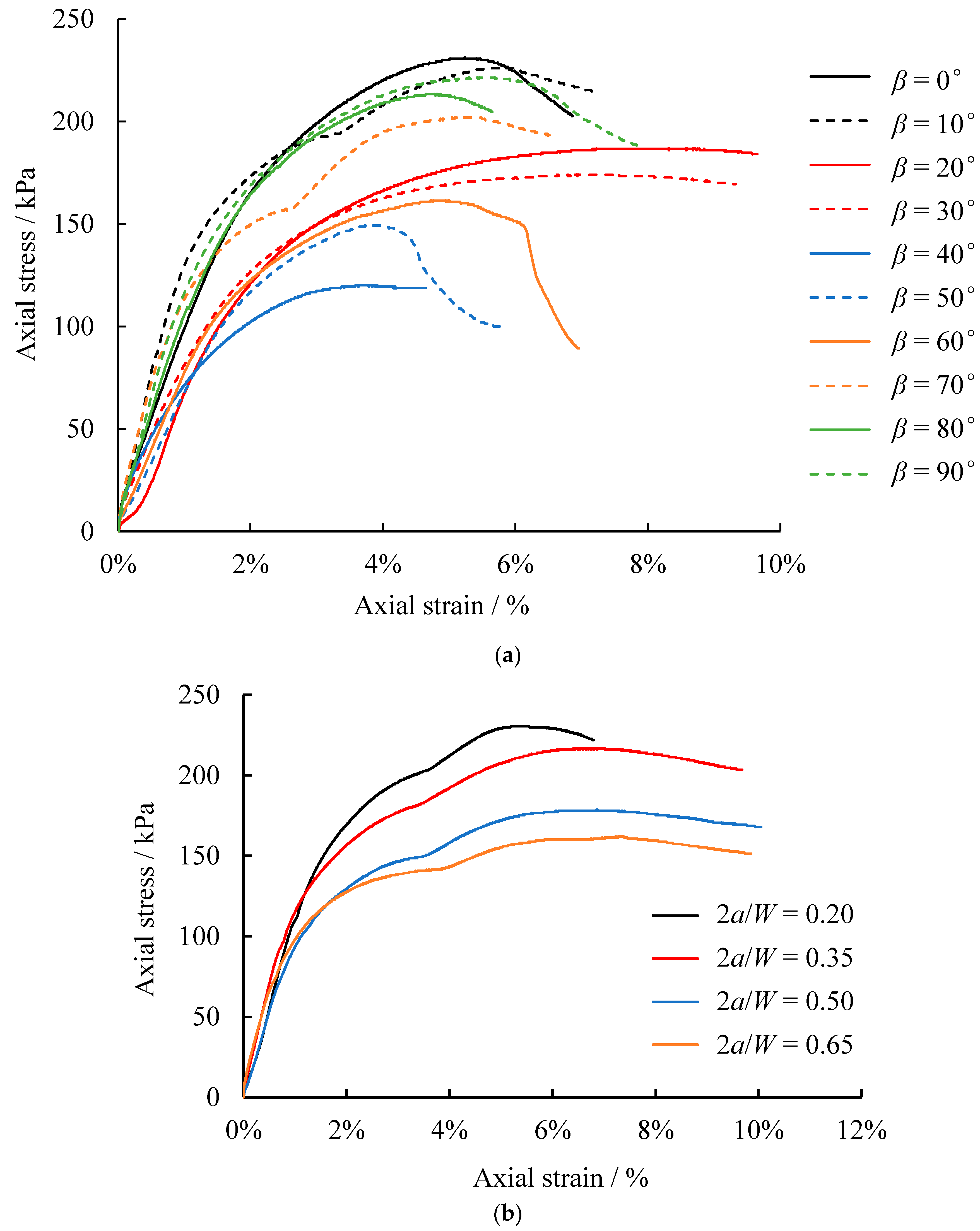

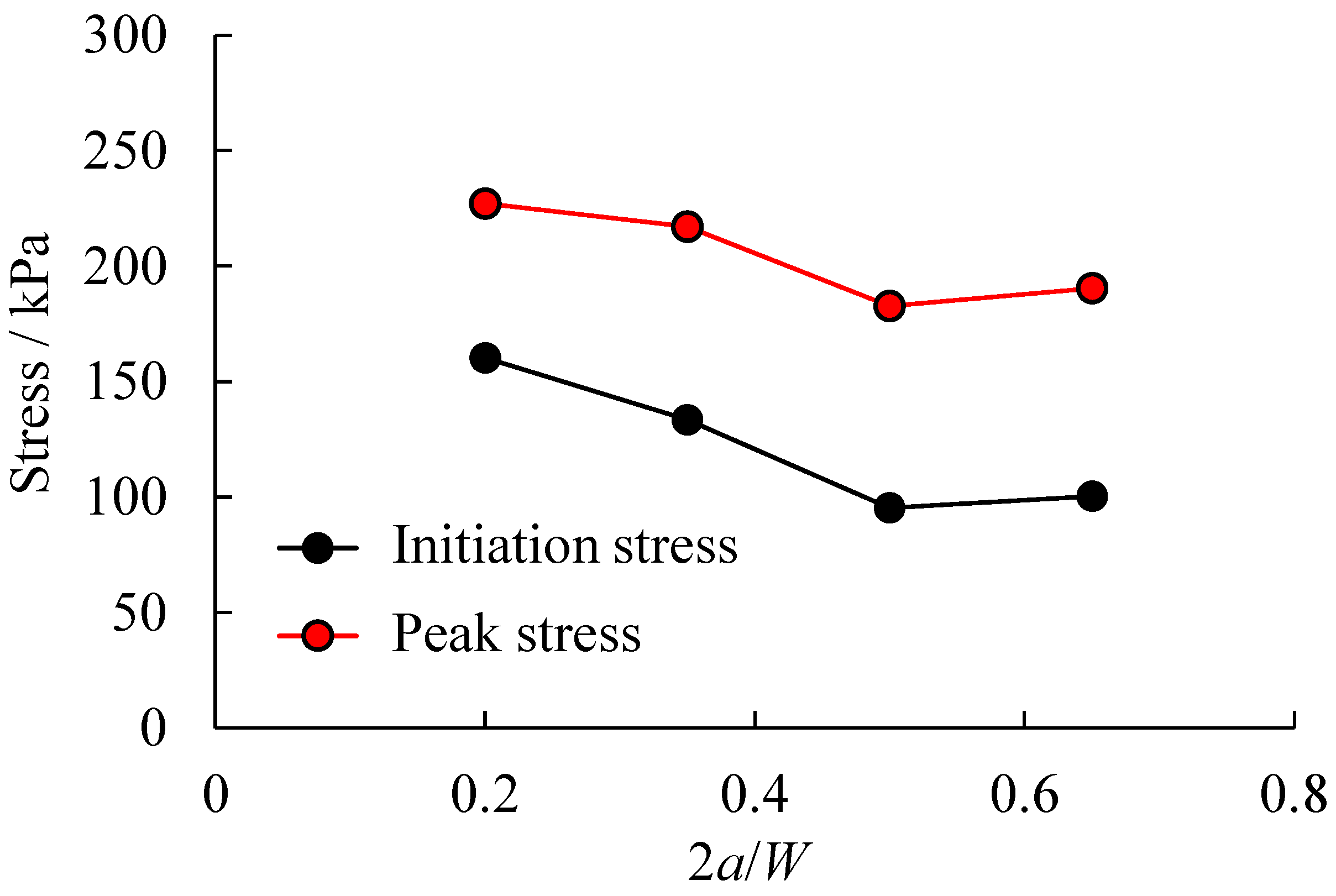
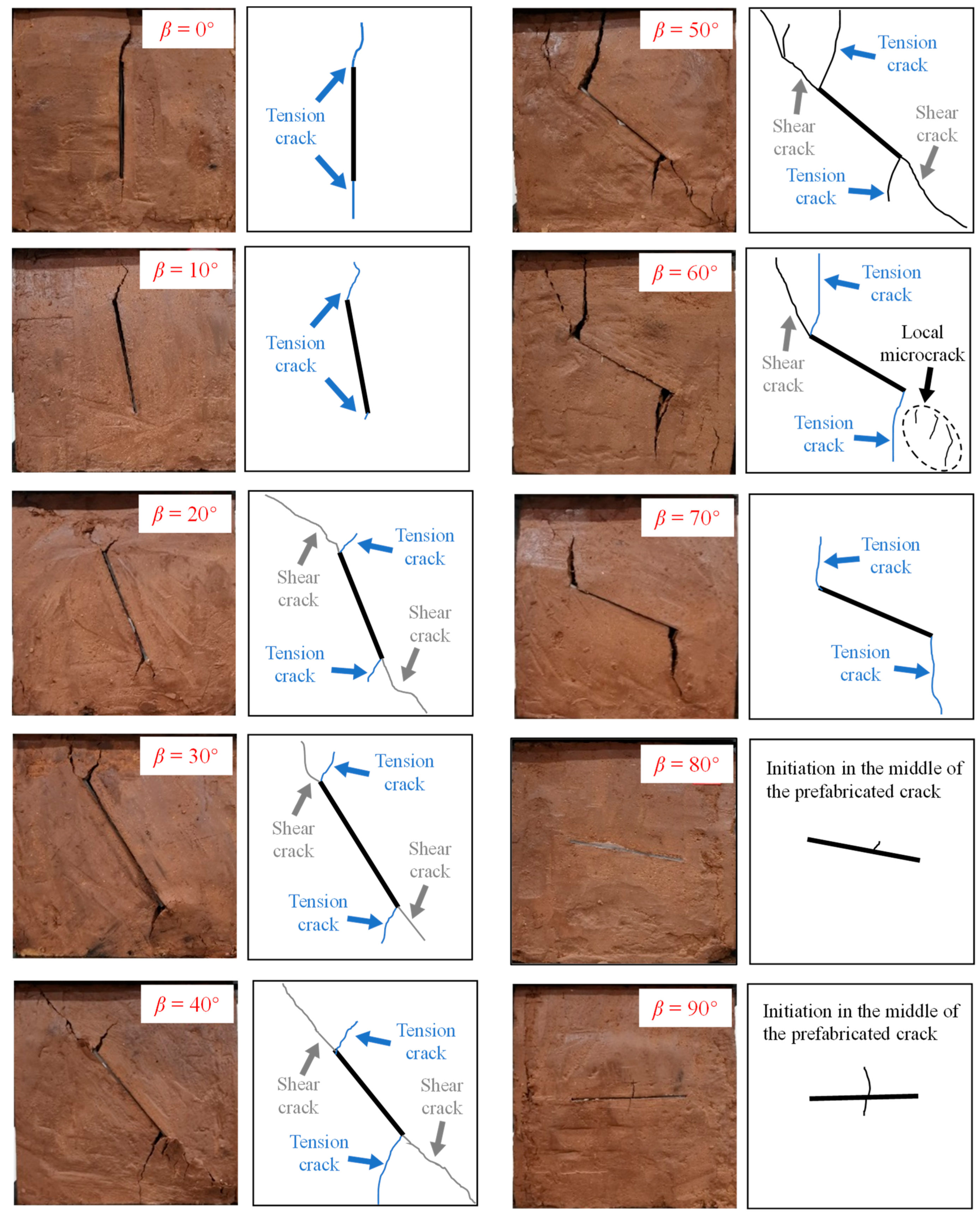



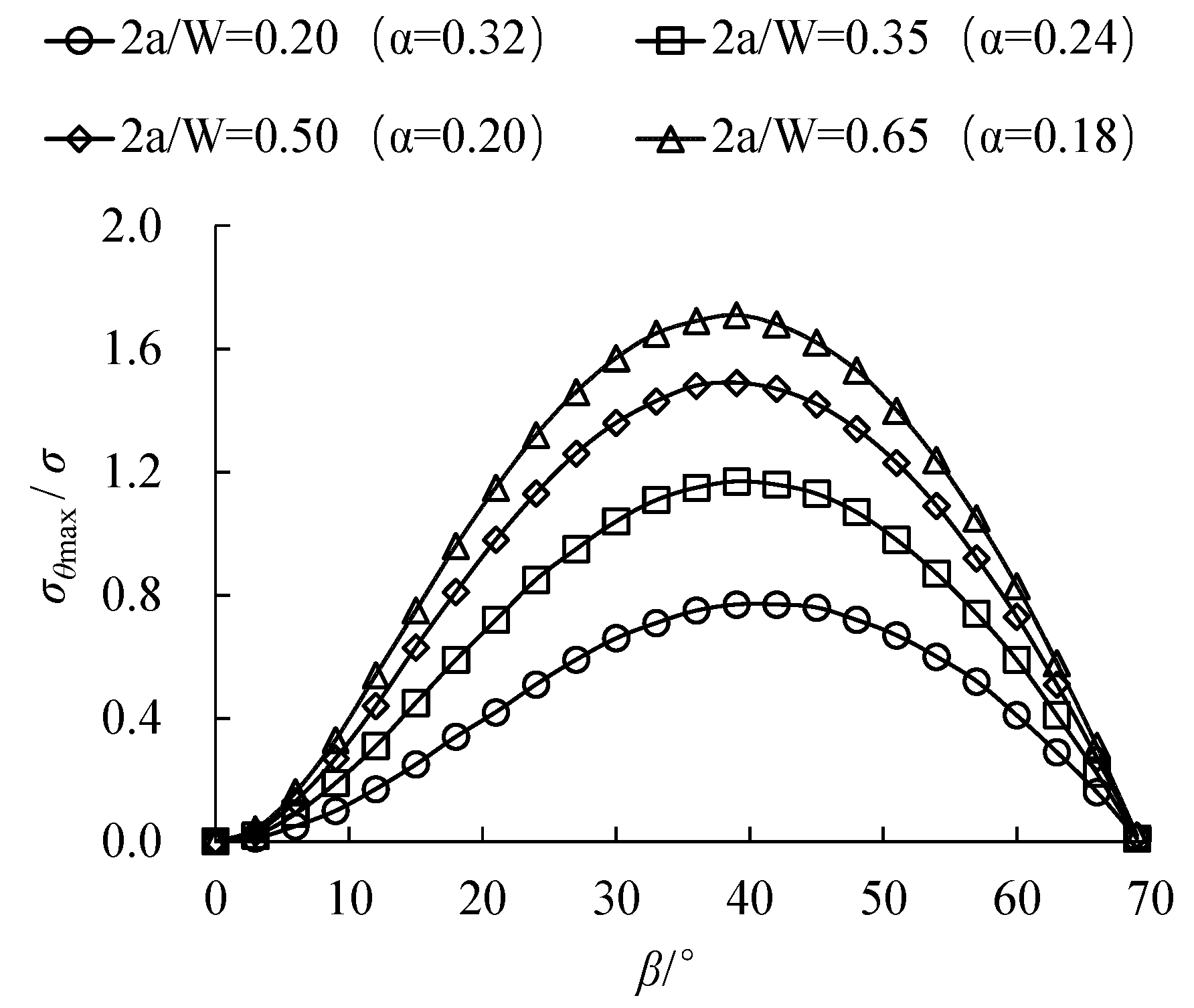
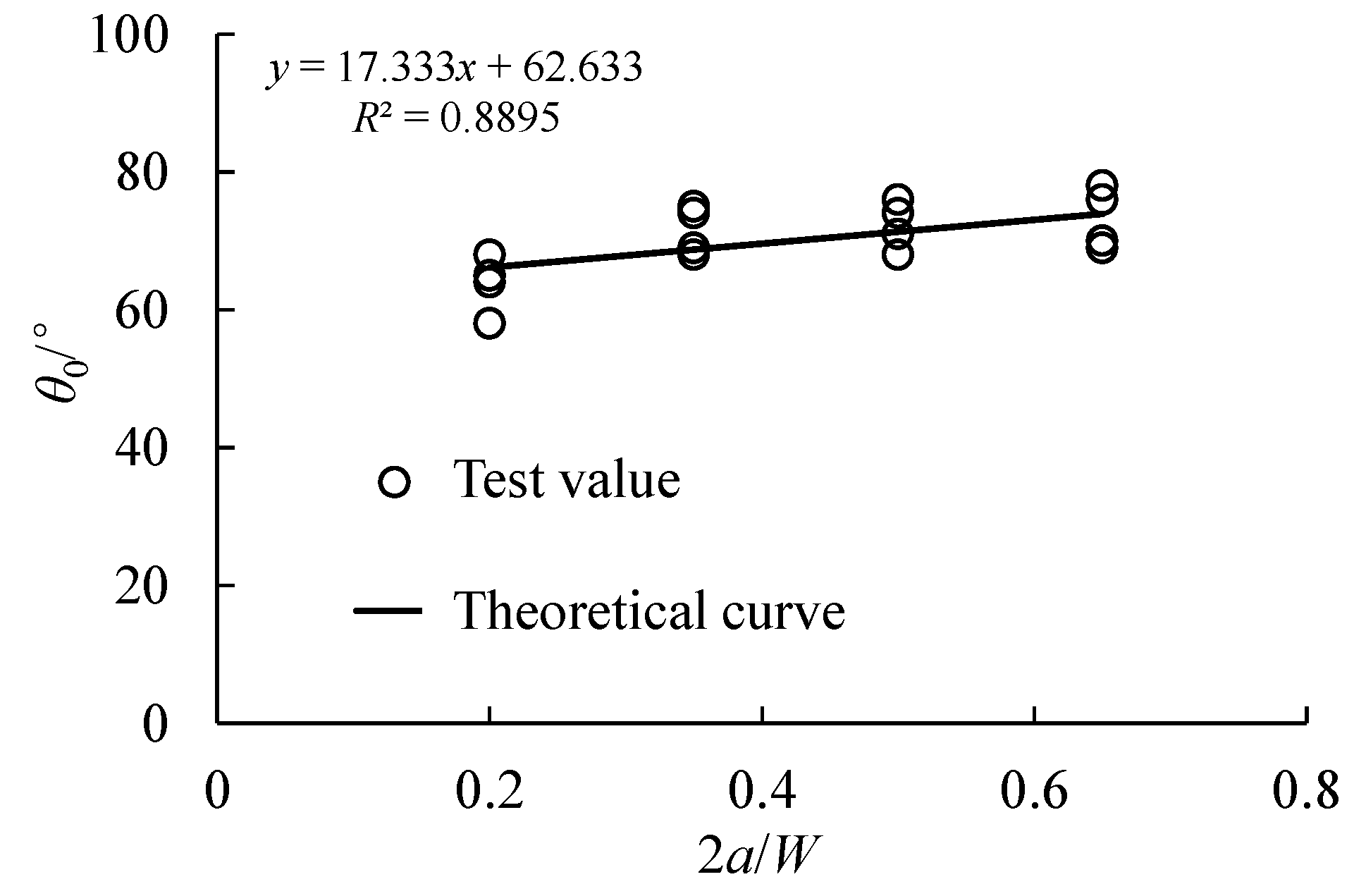
| Test Protocol | β/° | 2a/W |
|---|---|---|
| 1~10 | 0, 10, 20, 30, 40, 50, 60, 70, 80, 90 | 0.5 |
| 11~13 | 30 | 0.15, 0.35, 0.65 |
Disclaimer/Publisher’s Note: The statements, opinions and data contained in all publications are solely those of the individual author(s) and contributor(s) and not of MDPI and/or the editor(s). MDPI and/or the editor(s) disclaim responsibility for any injury to people or property resulting from any ideas, methods, instructions or products referred to in the content. |
© 2023 by the authors. Licensee MDPI, Basel, Switzerland. This article is an open access article distributed under the terms and conditions of the Creative Commons Attribution (CC BY) license (https://creativecommons.org/licenses/by/4.0/).
Share and Cite
Huang, S.; Zhang, X.; Yu, W.; Li, X.; Jin, S.; Du, H. A Theoretical and Experimental Investigation on the Fracture Mechanism of Center-Symmetric Closed Crack in Compacted Clay under Compression–Shear Loading. Symmetry 2023, 15, 1519. https://doi.org/10.3390/sym15081519
Huang S, Zhang X, Yu W, Li X, Jin S, Du H. A Theoretical and Experimental Investigation on the Fracture Mechanism of Center-Symmetric Closed Crack in Compacted Clay under Compression–Shear Loading. Symmetry. 2023; 15(8):1519. https://doi.org/10.3390/sym15081519
Chicago/Turabian StyleHuang, Shiyuan, Xiaofeng Zhang, Wenbing Yu, Xudong Li, Songyang Jin, and Hongbo Du. 2023. "A Theoretical and Experimental Investigation on the Fracture Mechanism of Center-Symmetric Closed Crack in Compacted Clay under Compression–Shear Loading" Symmetry 15, no. 8: 1519. https://doi.org/10.3390/sym15081519
APA StyleHuang, S., Zhang, X., Yu, W., Li, X., Jin, S., & Du, H. (2023). A Theoretical and Experimental Investigation on the Fracture Mechanism of Center-Symmetric Closed Crack in Compacted Clay under Compression–Shear Loading. Symmetry, 15(8), 1519. https://doi.org/10.3390/sym15081519





